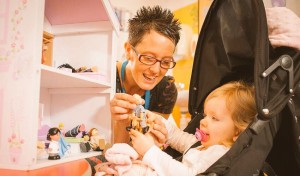 Play in its most intimate of forms allows for free expression, exploration, joy, and excitement . For others it’s a welcome distraction. What makes play become a tool, a balance barometer, a universal subject, is when it is introduced or offered to a child/young person (CYP) who requires an intervention, treatment or one who is in the midst of trauma or a long term diagnosis.
Play in its most intimate of forms allows for free expression, exploration, joy, and excitement . For others it’s a welcome distraction. What makes play become a tool, a balance barometer, a universal subject, is when it is introduced or offered to a child/young person (CYP) who requires an intervention, treatment or one who is in the midst of trauma or a long term diagnosis.
Clinical settings are strange, sterile environments, where your senses are overloaded, where you become overwhelmed by people, sounds, smells and sights – it’s a wonder that play has a place in such a frantic space or moment in time, but it does. For the hospitalised child enhanced information of their condition can lower a child’s fear and the pain they experience.
We have a small window of opportunity to introduce, assess, build trust and explain our roles to a CYP and their family, this is about the patient experience, how I can improve this as a service, and what tools I can provide to enable a CYP to feel listened to during this meeting, and how we can do this as healthcare professionals (HCPs) in a way that is honest and in the present? As HCPs in acute settings this should be part of the treatment plan and process of supporting CYP and their families, the recovery and coping strategies put in place would mean “Whole Being Care”.
There are “Moments of Specialised Play” these can be mini sessions of introductory play in order to build and gain trust, to allow contact within a CYP’s private space, or there can be short nuggets of contact – for one off procedures. There are the “Journeys of Specialised Play” – when the child or young person lives with a chronic condition that requires multiple admissions/procedures – perhaps it’s at this point we introduce a long term procedure plan to support future admissions.
As HCPs the challenge now is to look at our approach to CYP. What do we need to do to gain skills in specialised play, how can it be done in a way that promotes and provides a more balanced approach to health care impacting positively on patient experience, through a CYP’s eyes, and are these methods and processes accessible?.
So next time you have contact with a CYP think about how you can introduce play into the encounter, access the Health Play Specialists, ask them to share their knowledge. The use of a friendly head made from a glove, a well-rehearsed joke or the latest App on your phone is a great way of showing that you are present, and that the experience matters to you, and that you are engaged and ready to listen. You may sing, laugh, or pull a funny face, have hidden in your pocket the most amazing stickers, or you may sit alongside a young person on the floor, and acknowledge that right now it is tough.
In answer to the question “To Play or not to Play?” Why not, simply “to play”.
Sian Spencer-Little @spencer_sian
NNEB, Dip in Care, Cert in Therapeutic Play, Cert in Bereavement Counselling for
Play Specialists.
Specialised Play and Activity Practitioner.
Children’s Ward – The Princess Royal University Hospital.
Kings College Hospital NHS Foundation Trust.
Dr Hannah Baynes @HLB27
Consultant Paediatrician
The Hillingdon Hospital NHS Foundation Trust